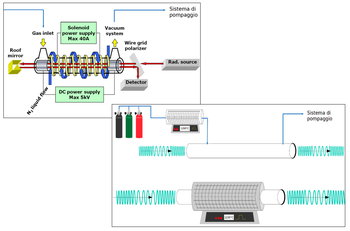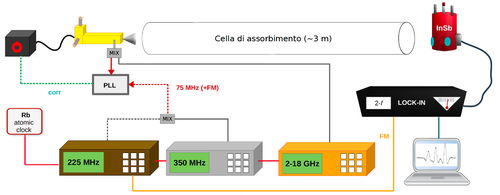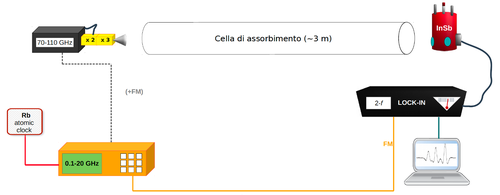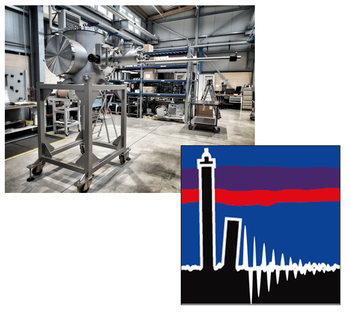Facilities

Frequency-modulated mm-/submm-wave (FM-mmW) spectrometers
Our instrument works with two set-ups, the schematization of which are shown below. The accuracy of the frequency and its phase stabilization are achieved in both cases using a rubidium frequency standard (10 MHz). Detection of the radiation can be done using several detectors: Schottky diodes (up to 500 GHz) and an InSb bolometer operating at liquid helium temperature (up to 3 THz). The radiation is demodulated by a Lock-in amplifier tuned to twice the modulation frequency, so that the spectrum profile turns out to be the second derivative of the natural profile.
Both set-ups can be used with different absorption cells (see attached image). One is equipped with two cylindrical electrodes and wires at both ends (continuous discharge system) and is covered with a plastic winding inside which liquid nitrogen can circulate; another cell is instead connected to a quartz reactor designed for Flash Vacuum Pyrolysis (FVP); the third is a quartz tube surrounded by an FVP furnace.

Set-up 1:
The MW radiation is produced by different sources: Gunn diodes operating in the range 75-134 GHz and/or passive frequency multipliers (x2, x3, x6, x9) driven by the Gunn diodes themselves (frequency range: 75 - 1600 GHz). These sources are phase-locked to the suitable harmonic of a frequency synthesizer referenced to an external runidium frequency standard. The frequency modulation of the radiation is obtained by sine-wave modulating the reference signal of the wide-band Gunn synchronizer.

Stet-up 2:
The radiation source is an active multiplier chain (VDI) that is driven by a synthesizer operating at centimetre wavelengths. Using a series of frequency multiplication stages, this set-up provides continuous coverage across the 82–900 GHz frequency range. Accurate frequency and phase stabilisation is achieved by providing the synthesizer with a 10MHz rubidium frequency standard.

Chirped pulse microwave spectrometer (6-18 GHz)
Currently in construction